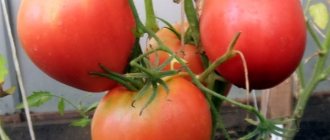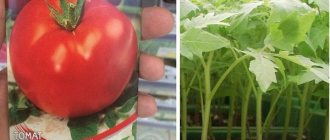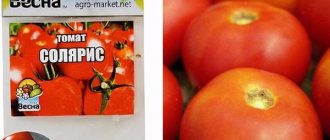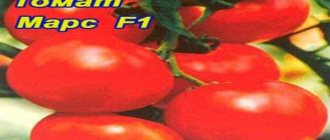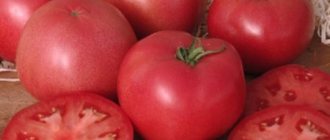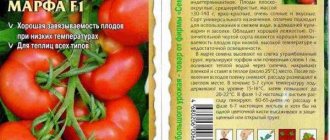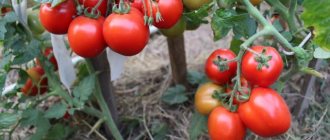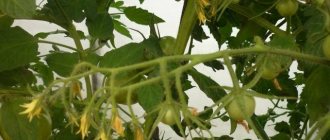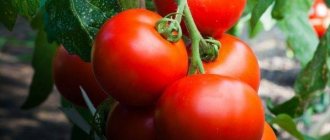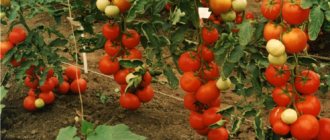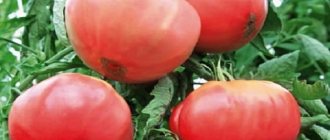Tomato Kolibri F1 is a high-quality hybrid that will satisfy the gardener’s need for tomatoes for preparations and various dishes. The fruits have a pleasant taste, tender and fleshy pulp without hard veins, which makes the hybrid universal in use.
| Height | Landing location | Ripening time | Fruit color | Fruit size | Origin | Fruit shape |
| Tall | Greenhouse | Early ripening | Reds | Average | Hybrid | Plum-shaped or oval |
Description and characteristics of the variety
Tomato Kolibri F1 was created by breeders from France. The variety is heat-loving and needs shelter - greenhouses and hotbeds. In warm regions it grows in open ground; some gardeners claim that they plant it on the balcony if the bush is allowed to form.
The plant is indeterminate, tall. The leaves are medium. Shortened internodes allow ovaries to form more often. 8-10 clusters appear on the stem, each containing several fruits. tomatoes ripen 95 days after seed germination.
The fruits look like large, oval-shaped plums. Weight - 160 g, diameter - 3 cm. The taste is pleasant, sweet and sour, classic tomato. The flesh is fleshy and not tough. Tomatoes are used for canning, salads, and cooking.
Due to their density, tomatoes are well stored and can be transported over long distances. Tomatoes retain their density even when cooked.
Description of the hybrid tomato Kolibri and growing the variety using seedlings
The tall tomato Kolibri is an early variety. It was bred by French breeders. Despite its southern origin, the vegetable has proven itself well in the temperate latitudes of Russia. It has become a subspecies of the famous variety Cream, which has strong stems and a small distance between the clusters. If agrotechnical rules are observed, the plant can bear fruit before the first autumn frosts.
Interderminate hybrid
Tomato Kolibri f1 is a tall plant. It is resistant to late blight due to its strong immune system. The green mass is formed by two stems. They most often form from 8 to 10 ovaries. The small gap between the nodes creates a ledge, which makes harvesting easier. Therefore, the bush must be constantly tied to a stable support and excess green shoots must be removed.
The agrotechnical characteristics of the development of the vegetable are determined by the height of the bush, reaching 2 m. The foliage on it is of medium size. It has a green and dark green color. The leaf blades correspond to the stem in their thickness and developed growth zone. The entire above-ground part is securely held by a strong root system.
The description of the hybrid fruit gives an idea of it as a vegetable with an original sweet and sour taste and remarkable properties. These include:
- versatility of use;
- dense and thick-walled pulp;
- significant mass - one tomato reaches 160 g;
- absence of unripe stem and veins inside;
- short ripening period - 3 months.
The plant belongs to the group of heat-loving varieties and is suitable for growing in greenhouses and greenhouses. The size of the vegetable allows it to be used raw, baked or canned. The density of the wall is such that when heat treated with boiling water at the moment of placing it in glass jars, the tomato peel does not burst. The fruits have good shelf life, so they can be delivered to remote regions.
Landing
The soil for transplanting future seedlings is prepared in the fall, and the seedlings are sown in March. Land preparation:
- digging the soil to a depth of about 30 cm;
- cleaning up last year's tops and weeds;
- in the greenhouse - replacement of the top layer of soil and disinfection (prepare a hot solution of copper sulfate or potassium permanganate, which is poured onto the ground);
- application of fertilizers (for example, a bucket of compost for each square meter or mineral fertilizers according to the instructions).
For tomatoes, do not choose beds after other nightshades: eggplants, tomatoes, peppers, potatoes. It is better to place seedlings in sunny beds after cucumbers, onions, legumes, and carrots.
To plant seedlings, prepare a nutrient substrate, which contains soil from the garden, a little peat and humus, and sand. Add 1-2 cups of wood ash and a couple of teaspoons of mineral fertilizer to a bucket of soil: nitrate, superphosphate. The mixture is disinfected by keeping the composition in the oven for about an hour at a temperature of +110. Spill with a hot solution of potassium permanganate.
The seeds are not processed as the hybrid seed undergoes proper processing before packaging. Growing seedlings:
- Make furrows 1-2 cm deep in the soil, leaving about 3 centimeters between rows.
- Sow the seeds, pour a thin layer of soil on top, and spray with water from a spray bottle.
- Cover with film or glass.
- Keep in a warm place for several days, until more than half of the shoots appear.
- Open the container and reduce the temperature to +16 for three days.
- After three days, set the temperature to +18-22.
- Keep the boxes on the windowsill, periodically turning the other side towards the sun. Daylight hours are at least 12 hours.
- Feed the seedlings 1-2 times with a weak solution of mineral fertilizer or a preparation for seedlings.
- 10-14 days before planting in a permanent place, the bushes are hardened off, taking them outside every day.
- After 55-60 days, the seedlings are ready for transplanting.
The recommended planting pattern is 70 by 50 cm.
Characteristics of the Hummingbird tomato, its yield, reviews
Tomatoes of the Hummingbird variety are perfect for pickling and marinating. They have an attractive and small shape and look nice in a jar. The elastic skin protects the tomato from cracks and prevents juice from leaking out. The tomatoes taste sweet and juicy.
Tomatoes of the Hummingbird variety contain a balanced composition of vitamins and other nutrients. Their consumption has a positive effect on the functioning of the heart, liver, and kidneys. Tomatoes activate the body’s protective function, making it less susceptible to diseases.
Characteristics and description of the variety
The Hummingbird variety is resistant to low temperatures, so in most regions of the country it can be grown directly outside. Planting in open ground is carried out depending on weather conditions. When the street temperature is at least 17 degrees and the ground temperature is at least 10 degrees, the tomatoes are planted in the street soil. This usually happens in mid-May. Greenhouse planting is also acceptable for this variety. In this case, tomatoes are planted in early May.
The fruits are neat, the average weight is no more than 150 grams. The diameter of the tomato is 30-35 millimeters. Their compact size allows you to use tomatoes for winter preparations, as they can easily fit into any jar and do not need to be cut.
The plant is formed into one or two stems. Tomatoes are formed in clusters, each cluster containing from 7 to 10 fruits. Tomatoes tolerate frost and heat well. The variety is also unpretentious in cultivation, grows in almost any soil and does not require excessive attention.
A hummingbird in comfortable conditions is capable of producing the highest possible yield. 13-15 kilograms of tomatoes are grown on one square meter.
Seeds are planted 60-65 days before planting in the ground.
Features of cultivation and care
Before planting, you need to prepare the seeds and soil. Peat and humus are added to the soil, the lumps are broken up and calcined at a temperature of at least 80 degrees. You can bake it in the microwave or in the oven.
The seeds are soaked for a couple of minutes in a weak solution of baking soda. Then they are washed and placed on a saucer moistened with water. Under moist conditions, the seeds begin to germinate quickly, and by the end of the third day you can see young shoots forming from them.
Sprouted seeds are planted in the ground to a depth of no more than 1 centimeter. After planting, the soil is spilled and covered with plastic film on top. Place the container with future seedlings on the windowsill. In the evening, special lamps can be used for lighting. The more light young tomatoes receive, the faster they will grow.
When the plants reach 35-40 centimeters, they can be planted in a greenhouse or open ground. After replanting, the tomatoes are allowed to take root for 3-5 days, and then they begin to water once a week and loosen the soil. It is imperative to remove weeds and foreign plants from the soil. They interfere with the growth and development of the root system.
It is advisable to pin the tomato stem, this will lead to greater yield. Stepping is carried out in the morning. Use your hand or knife to cut off the unnecessary shoot. The tomato juice that flows from the plant is poisonous to human skin and can cause allergies. Therefore, when threading, you should always put on gloves in advance.
At the height of summer, watering is increased to 3-4 times a week. Leaves should be sprayed no more than once a week. Excessive waterlogging leads to late blight and other fungal infections. When watering, growth stimulants are used. These can be nitrogen and potassium fertilizers. Good results in growing tomatoes are achieved by watering with chicken manure. Dilute 200 grams of droppings in a bucket of warm water and water the plant at the root once every two weeks.
Do not forget to ventilate the greenhouse, open the windows and doors, and create drafts. Tomatoes, like most vegetable crops, need constant access to fresh air.
Tomatoes begin to ripen on the bushes by mid-summer if they were grown in a greenhouse or greenhouse. Only completely red fruits should be picked. If the weather is bad and severe frosts are expected, then tomatoes grown outside are picked green. There is nothing wrong with this, the tomatoes will be just as tasty and red, they just need to be allowed to lie in a warm place. In just 2 weeks they will ripen, and their taste is indistinguishable from greenhouse tomatoes.
The largest tomatoes are selected and set aside. They are used for planting next year. To do this, remove the pulp and seeds from the fruit and place them in a container with water for 2 days. After the time has passed, the contents of the jar are poured into a colander and washed with water to separate the grains from the pulp. The peeled seeds are leveled on a newspaper or piece of paper and dried at room temperature. Then the grains are poured into a jar for storage. It is better to sign it, so it will be clear what type of tomato is in it.
Advantages and disadvantages
The Hummingbird variety is popular and has many positive qualities. This:
- Hard peel and juicy sweet flesh.
- Early ripening.
- High yield.
- Immunity to tomato diseases.
- Tomatoes' unpretentiousness when choosing soil.
- Possibility of planting in open ground.
Tomatoes of this variety are often used not only in preparations; they can be cut into salads. The tomato slices hold their shape perfectly and do not fall apart.
Reviews from gardeners about tomatoes
Here is what Alena from the Nizhny Novgorod region writes about Kolibri: “My neighbor in the country recommended Kolibri to me. I took a couple of bushes from her for greenhouse planting. I liked the tomatoes, they are just right for pickling, they don’t burst or tear.”
Nadezhda from Tver says: “Tomatoes of this variety grow well in open ground. The tomatoes stood until late autumn and did not fall. They taste sweet. I pickled and salted the tomatoes; they even fit into small liter jars.”
Growing and care
The tomato is formed and tied to a support. The bushes grow into two stems.
In a greenhouse it is watered once a week, in open ground - depending on the weather. The water is heated. Pour liquid under the root. To prevent the tops from getting burned, watering is carried out in the morning or evening at the root. They loosen the ground and hill up the bushes.
Feed the bushes at least three times, in the greenhouse - 5 times:
- For young plants, solutions of urea, mullein, and fermented herbal infusion (nitrogen organic fertilizers) are applied at the root.
- With the beginning of flowering, most of the fertilizing is made up of mineral preparations.
- During fruit ripening, the leaves are sprayed with solutions of boric acid or ammonia, which accelerates ripening.
Care
Seeds can be planted both in open and closed ground. The lashes in the open area are covered with film; trellises are used for convenience: this speeds up development. Before planting on the site, the seeds are germinated. By planting seeds using the seedling method, you can get fruits earlier than the specified dates.
Productivity depends on care
Kolibri F1 cucumbers do not require special care, but following the rules contributes to the development of a high-quality harvest
To grow strong cucumber fruits, you need to pay attention to:
- watering mode;
- fertilizer;
- loosening and formation of bushes.
Watering
Cucumbers need a lot of moisture. Before active flowering begins, it is necessary to apply 5 liters in dry weather and 2 liters after precipitation. During fruiting, cucumbers require up to 8 liters of water during drought and 5 liters after rain.
It is necessary to water the bushes in the morning with warm water. Evening watering when planting in spring can cause cooling of the root system due to unstable temperatures.
Loosening
Precipitation and irrigation lead to the formation of a hard crust on the soil surface. Its appearance can slow down the development of lashes. After watering, the soil is loosened.
Fertilizers
Fertilizing is applied at least once during the period of active growth. Mixtures containing nitrogen, potassium and magnesium are used as fertilizers. Some additionally fertilize the bushes during irrigation.
Organics are popular for feeding bushes:
- infusion of onion peel;
- dairy products;
- diluted chicken droppings or animal manure.
Forming a bush allows the vines to receive the maximum amount of sunlight. This improves the quality of the fruit. Only the lower side shoots should be cut off, while keeping the central stem and other vines intact: they form ovaries that participate in the formation of cucumbers.
Description of the variety
The Kolibri tomato variety is a first generation hybrid. This is indicated by the designation f1.
The hummingbird was bred by French breeders. The variety belongs to heat-loving crops. Designed for growing in greenhouses and greenhouses.
It is characterized by persistent immunity to many diseases and rare late blight.
Tomato seeds are relatively inexpensive. The variety gives a bountiful harvest. During the season you can harvest an excellent harvest with minimal costs for planting material and chemicals.
Characteristics
Tomatoes of the Kolibri variety produce large oblong fruits weighing up to 160 g. Tomatoes have a balanced composition and sweet and sour taste.
Thanks to the large number of fruits on one cluster, more than 10 kg of harvest can be obtained from one Hummingbird bush. Tomatoes are harvested before the first frost.
Kolibri tomatoes are meaty. Inside there are 4-5 chambers with seeds, which, due to the hybridity of the variety, are not suitable for cultivation. The color of the tomato skin and pulp is red.
The fruits are suitable for canning and fresh consumption. Therefore, the variety can be considered universal.
Characteristics of Hummingbird
The characteristics of the Hummingbird variety will impress the most experienced gardener.
Description of Hummingbird tomatoes:
| Parameter | Indicators |
| Bush type | Indeterminate. Bush with constant growth. It can grow up to 2 m high. The stems and leaf blades are powerful. They have a dark green tint. The root system is developed. |
| Growing method | Belongs to heat-loving, heat-resistant varieties. Recommended for growing in greenhouses (both heated and unheated). |
| Productivity | The variety is high-yielding. Up to 10 fruits grow on one cluster. From 1 sq. m harvest 10-15 kg of tomatoes. |
| Fruit | Bright red inside and out. They have an oblong oval shape. The tomatoes are juicy, dense, fleshy and thick-walled. They have a rich aroma. They have a sweet and sour taste. There are no green veins inside, and green spots outside. |
| Transportability | Good. Tomatoes have thick skin. They can be stored without losing their shape for a month. |
| Ripening time | Early ripening. The ripening period is 95 days. Refers to all-season varieties. |
| Disease resistance | Resistant to verticillium and fusarium wilt, tomato mosaic and nematode. Rarely affected by late blight. |
Harvest and use
In mid-summer, the first ripe fruits appear on the Hummingbird bushes. Tomatoes are harvested by hand, leaving the stem, which will help them last longer and ripen faster.
It is important to pick ripe tomatoes in a timely manner to prevent late blight from damaging unripe fruits.
Green fruits ripen when picked. After two weeks, it is difficult to distinguish them from tomatoes that have ripened in the garden.
Kolibri tomatoes have a sweet and sour taste. According to reviews from gardeners, they are ideally suited for conservation.
Growing tomatoes
Tomato Kolibri is a greenhouse variety. In a greenhouse, you can get the most abundant harvest. At the same time, the plants are resistant to heat and frost.
Hummingbirds are easy to care for, rarely get sick, and have good yields even in the absence of regular feeding. A novice gardener can easily cope with growing a hybrid.
Planting seedlings in the ground
The seedlings are transplanted into an unheated greenhouse two months after the seeds germinate. Planting takes place in the middle or end of May. By this time, the morning frosts have already subsided.
Compost and ash are added to the soil for planting tomatoes. Undiluted manure should not be added; such fertilizer will lead to the death of tomatoes.
Pros and cons of the plant
The plant has more positive qualities than negative ones. The bred breed has recently been able to gain trust, reviews and popularity among many gardeners. The advantages of the plant are:
- Indeterminateness;
- High yield;
- The plant has a good immune system and is resistant to many viruses and diseases;
- The tomato does not require frequent care;
- The fruits are fleshy and characterized by good keeping quality and are easy to transport;
- Vegetables do not crack when preserved;
- The tomato is adapted to different growing zones;
- The variety has early ripening periods.
The downside of the plant is that it needs to be tied up and pinched. Also, the crop is a hybrid, so you cannot get the seeds yourself. But thanks to a good harvest, the crop is worth it.
